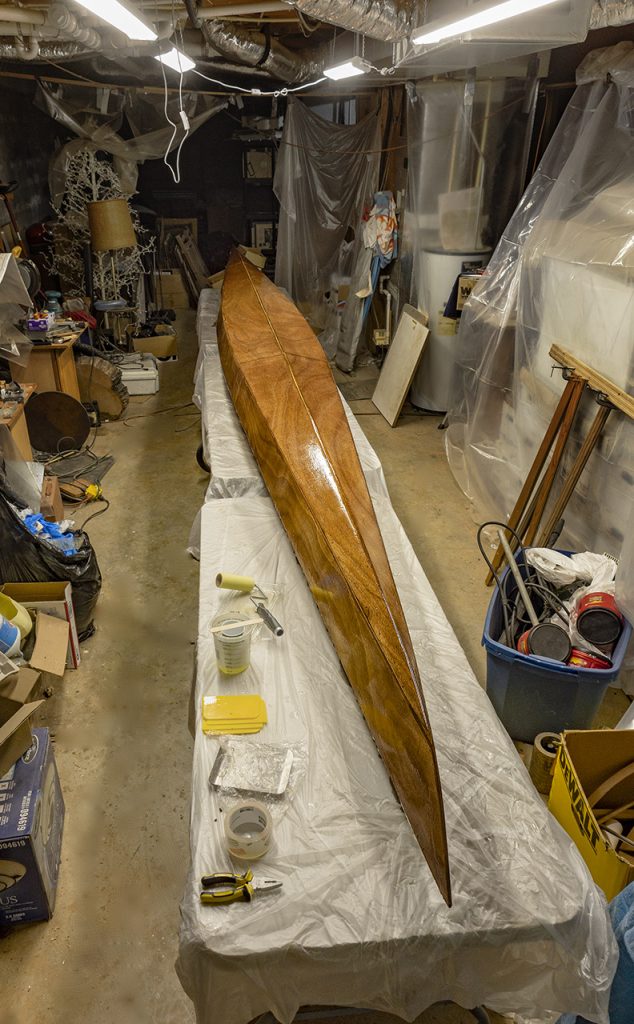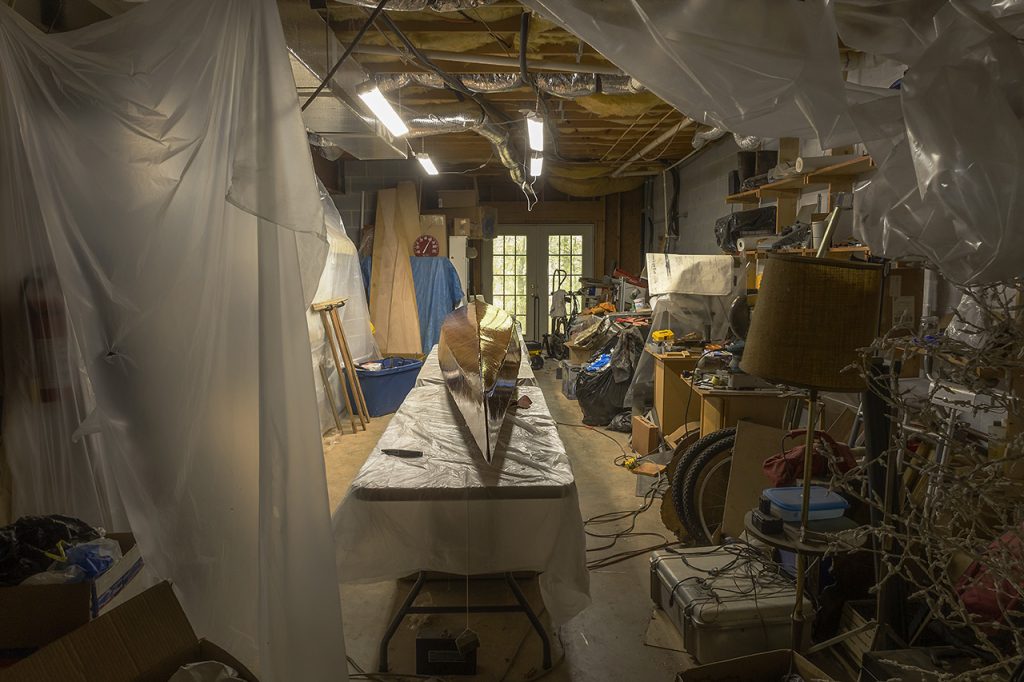I put a second coat of epoxy on the fiberglass last night and a third this morning. To review: the first coat is to bind the glass to the wood and begin filling the weave. The second coat might fill the weave if the first was sufficiently uniform, but the need for a third is no surprise (a fourth, etc., might be called for since I’m a complete newb). Eventually, the epoxy will cover the glass fibers under a not-entirely smooth surface, one that can be sanded smooth without damaging the glass. Here’s a boatbuilders tip from CLC that addresses this particular step: filling the weave.

,,,
A few notes about the first coat: the bias in the cloth is your friend. When in doubt about smoothness and fit, wet the fiberglass by drawing the roller along the bias (45 degrees between the warp and weft). The cloth will stretch without bunching or folding. Also, the bias can work for you in covering odd edges and shapes. When things do bunch up, it’s the bias that will often save you if you just work with it, rolling along the bias and letting the stickiness of the epoxy do the subtle pulling.
When I couldn’t pull the roller straight down the sides without rolling in a bubble or a crease, I rolled at an angle toward the bow. This worked fine until I got to the last 6-8 inches, when all the stretches and excess efforts to flatten bubbles and realignments came due: one side of the bow was no longer completely covered. I just cut the cloth short and resigned myself to applying a patch or patches (I coated the wood to hold things in place then folded and wetted out small patches of cloth to finish the coverage). In any case, I will not mind a few extra grams should they be needed to insure that the wood is protected and the nose strong. In the stern, I took a slice and wrapped one side of the cloth around the stern and overlaid it with the cloth from the other side (see the third video in the previous post). Actually, that did not work so well, and I need to reconsider how to insure a good seal back there.
The first coat was fraught because it was unfamiliar and because structural strength was at stake. The second coat is easy to over do: the epoxy will run since there is nothing for it to soak into. Light coats really are the name of the game for subsequent applications. I began the second coat five hours after the first, when only a few spots were still tacky, and the rest of the first coat was firm but still impressionable to a very firm touch. Tip: if you have any epoxy left over after applying the last of the second coat, resist the urge to dump it somewhere and roll it over “the thin spots.” That way lies runs. The little aluminum roller appeared to be pretty good about breaking up and redistributing small pools of epoxy, but it’s not a killer tool (I cleaned it up and put it away). I would have used the foam roller, but I had already fought it off the handle and tossed it before I saw some relatively irksome epoxy ponds.
This morning, I applied a third coat. I did the first two with a foam roller, but I used a 2-inch foam brush for the third. I sanded the patchwork at front and back and then began with areas where the weave was still clearly unfilled. Then I went over the entire hull lightly. It soon became easy to feel the roughness of incompletely filled glass. Whenever I did, I brushed on a slightly heavier load of epoxy until the brush glided smoothly over the areas. The third coat took about an hour. I finished by going back over the boat looking for runs and overlooked bits, and then I stepped away.
Sooner or later, I’ll need to sand the epoxy in preparation for paint (or, God help me, for varnish).
Late this evening, I applied epoxy to just a few spots where the weave was close enough to the surface to make its presence known. I scuffed such areas with 220 grit and re-dressed those few square inches. It’s not really a fourth coat. A few patches seem to refuse to take the same level of epoxy as neighboring wood. Contaminants? Errors in an earlier age of the boat? I think it is nothing serious — I’m sure there’s plenty of epoxy in the glass and none of it is ever leaving the wood — but puzzling.
I trimmed away most of the excess fiberglass (a carpet knife made fast work of that). What little is left will disappear when I plane the sheer clamps to match the curve of the decks.

…
Several steps loom that involve scuffing: epoxy before a final coat; epoxy before paint; varnish between coats on the deck. Maybe I’ll need Scuff pads? Wet sandpaper and a sanding block? What grades? I’ll look that up soon enough; I’ve no need to look for things to worry about that many steps ahead.
As the wood becomes more beautiful, I start thinking of varnish instead of paint. If I left the finish “natural,” this boat would resemble Max Schmitt’s boat in Thomas Eakins’s most famous work.

There are pros (everybody adores a wooden boat) and cons (runs and infelicities, messy joinery, and a few wrinkles in the glass). There’s no need to decide anything right now, but paint is still a good bet. I can admire the wood until then.
Also today: I mailed back the resin and hardener I ordered back in the beginning. I was simply confused about kinds and amounts and astonished that the original epoxy in the kit was in good shape. MAS was very helpful and understanding.
This is a good time to just let it sit for a couple of days to (1) let the outer glass cure 100% and (2) get the mind around the remaining tasks.
Next up,
in pretty much this order: glue the deck beam; plane the sheer clamps to match the curve of the decks; install the deck beam; glue up the small scarf on the foredeck; paint the inside of both decks with epoxy; decide about hard points; put the decks on; and trim the decks to fit. Somewhere along the way I have the skeg and inspection hatches to deal with, and each item will require at least some prepwork. After that, fillers (and cockpit fillets), paint, and varnish. There’ll be some sanding along the way — something between “some” and “a lot.” Also, all those tasks I’ll think of along the way. Only a few big items remain on the list to a completed hull, but small items will surely multiply. Previous advice and wisdom to not think too far ahead apply.